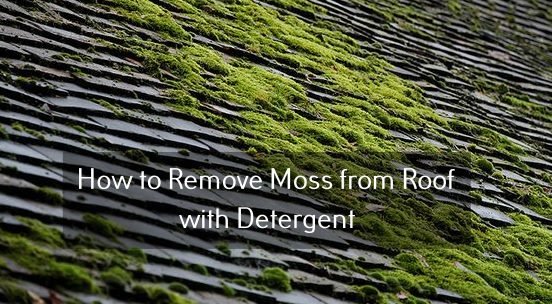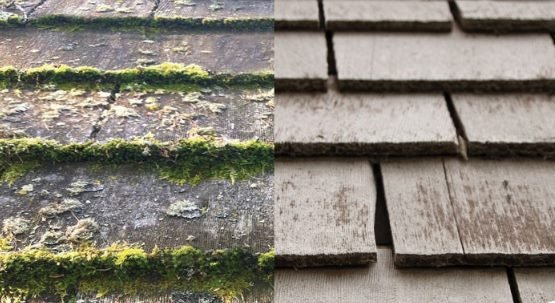When green moss forms on your roof, you may think it creates a rustic and cozy impression. However, for the roof itself, moss means bad news. An unwanted intruder may cause severe damage by allowing the water to permeate inside.
The only way to prevent the damage is by regularly removing them. Learn how to remove moss from a roof with detergent by reading the following guide.
How to Remove Moss from Roof with Detergent
It’s not only you: most people seem to think that having a moss-covered roof creates a dreamy and homely cottage vibe. However, Moss is more like a nightmare than a fantasy.

The green clumps may cause degradation to the area if left untreated and even shorten the roof lifespan, especially if you use asphalt, wood, clay, or concrete roofing material.
So, what is most, actually? It is a thin layer with a green color that develops and resides on and in between roof shingles. Once it layers on, it will raise the shingles as if they grow, thus opening a chance for water to seep in.
It would help to treat it as soon as you notice the problem. Tackling the issue before the rainy season in fall will be the best time of year to remove moss from the roof; otherwise, early spring and mild winter would do, too.
Luckily, moss is quite easy to get rid of. Here are the steps on how to remove moss from a roof with detergent:
- Set a ladder near the moss-developing area. Wear safety measures such as eye protection, gloves, and anti-slip shoes.
- The next step in removing mold from roof shingles is to direct a water hose to the affected area at a downward angle. Rub the water with clothes carefully—no need to scrape or pound. Work from a small section and move to another.
- On the nearest cloudy day, start to remove the moss using a detergent or chemical solution of your choice. You should wait until the day is cloudy to ensure the solution won’t evaporate speedily. Scrub the solution into the affected area gently but thoroughly.
- Install sheet metal with copper coats or zinc strips to prevent the moss from developing again. Set the metal underneath the upper ridge on the roof’s sides. Zinc is less expensive, but copper is more effective in preventing algae and moss.
A detergent solution is a material that must be used with caution. While it indeed can kill the moss on the roof and seems like a practical alternative, it’s not the ideal substance to use on the roof.
Repeated use of laundry detergent can damage your roof. Although it’s more cost-effective than hiring a professional moss remover, it might not be the best long-term solution. Opting for specialized roof-cleaning products could preserve the integrity of your roof better than general Tide detergent.
Another alternative that’s safer than detergent is by using roof moss removal chemicals with specific cleanser formula :
- Wet and Forget, spray-on product to eliminate mildew, moss, and mold;
- The advanced 2-in-1 cleaner that contains potassium soap and other effective ingredients to erase algae and moss;
- Moss B Ware, powder products with zinc sulfate monohydrate ingredients.

Whichever product you pick to help you with the problem, make sure to follow the manufacturer’s application instructions.
Read also: Roof Shingles Colors Most Popular
Moss not only damages the structural integrity of roofing materials but also affects aesthetic appeal, potentially decreasing a property’s value. Regularly inspecting and cleaning your roof can prevent moss from taking hold.
If you choose to use a detergent, ensure it is suitable for the roofing material and follow all safety guidelines to protect yourself and the roof structure during the cleaning process. Additionally, consider consulting with roofing experts if you’re unsure about the best moss removal strategy for your home.
There is no thumb rule about how often your roof must be cleaned to avoid moss. It may depend on the conditions of the roof. Follow the guide on how to remove moss from a roof with detergent above if you started to notice its growth, so pay regular attention to your roofing area.


